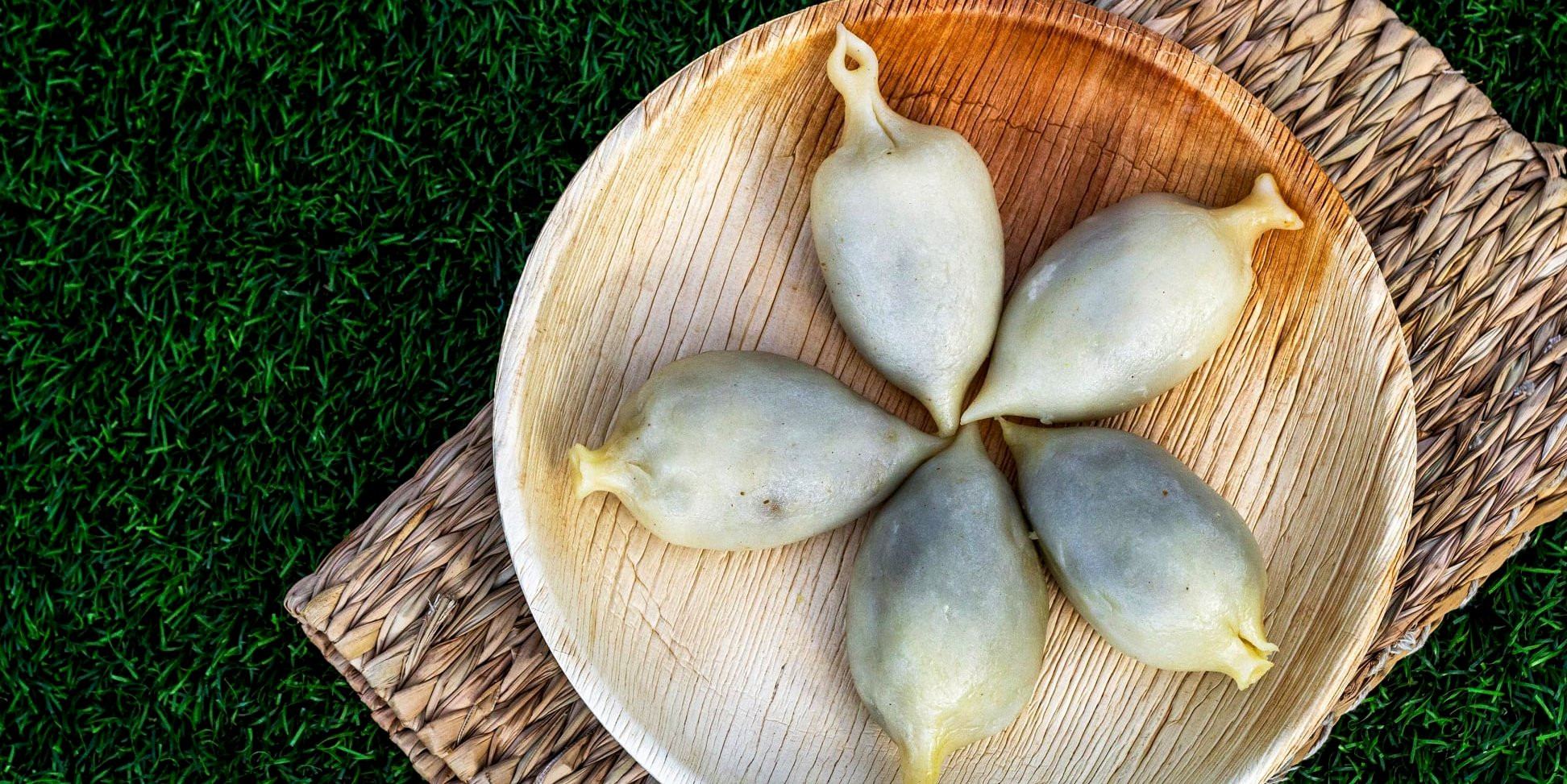Momos
Momos are one of the most beloved foods across Nepal, cherished for their delicious simplicity and the variety they offer. These dumplings originated from Tibetan communities and have become a staple in Nepalese cuisine, spreading in popularity across the entire South Asian region.
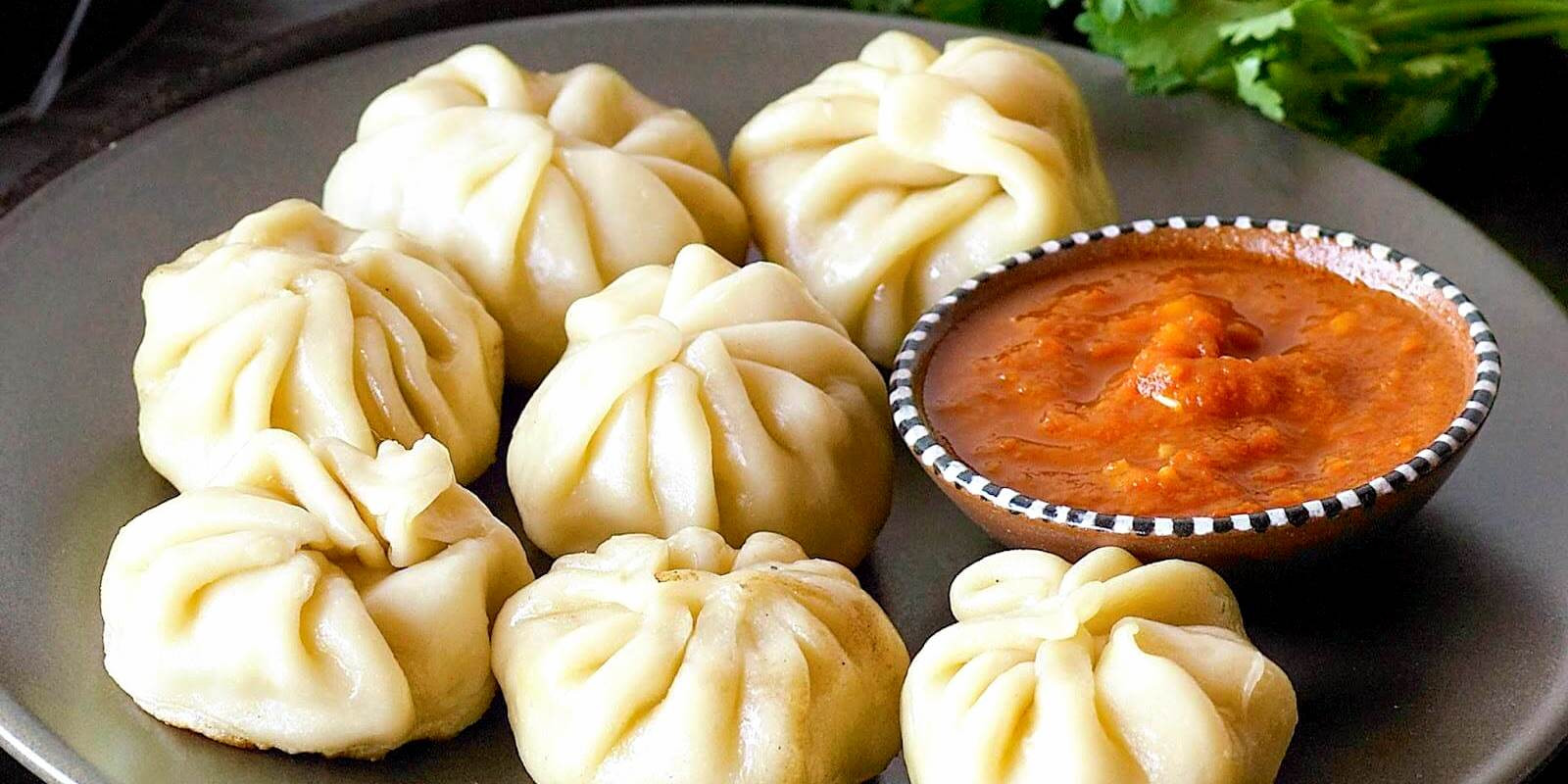
-
Ingredients and Varieties: Momos are traditionally made with a simple flour and water dough, wrapped around various fillings. The most common fillings include minced meat (such as chicken, buffalo, or pork), vegetables (commonly cabbage, onions, and carrots), or a mixture of cheese and vegetables. The filling is seasoned with ginger, garlic, turmeric, cumin, and coriander, among other spices, to give it a distinctive taste that's both fresh and aromatic.
-
Preparation and Serving: Momos can be steamed, fried, or sometimes even baked, though steaming is the most traditional method. They're usually served hot with one or more dipping sauces, which can range from a mild tomato-based chutney to a fiery sesame and chili sauce. The contrast between the soft, juicy filling and the doughy exterior makes them an irresistible treat at any time of the day.
-
Cultural Significance: In Nepal, momos are more than just food; they are a cultural phenomenon. They are a popular choice for family gatherings, and festive celebrations, and are widely available from street vendors to high-end restaurants. Eating momos is typically a communal activity, shared among friends and family, which makes them a culinary experience as well as a social one.
-
Modern Twists and Variations: While traditional momos remain popular, new variations emerge, incorporating different fillings like cheese, tofu, and even fish. Some innovative chefs have also introduced fusion momos, combining flavors from Chinese, Indian, and other global cuisines, reflecting the versatility and adaptability of this beloved dish.
Whether you enjoy them simple and steamed or spicy and sautéed, momos offer a delightful taste of Nepali culinary craftsmanship that is hard to resist.
Dal Bhat
Dal Bhat is the quintessential Nepalese dish, a staple that holds a central place in the nation's culinary heritage. Often referred to as the ultimate comfort food of Nepal, it provides a balanced, nutritious meal and is eaten with great relish by locals and travelers alike.
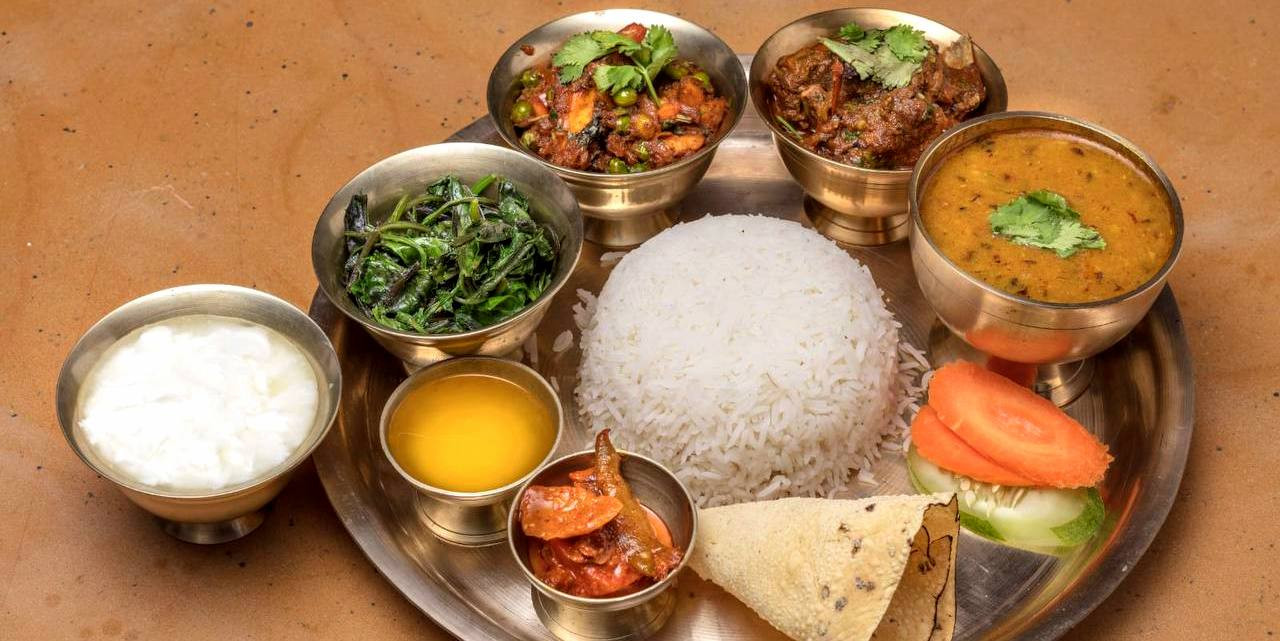
-
Composition and Ingredients: Dal Bhat is a two-part meal consisting of dal (lentil soup) and bhat (rice). The dal is typically made from lentils such as black lentils, yellow lentils, or split peas, and is seasoned with turmeric, garlic, ginger, and cumin. The rice is usually a simple steamed preparation. Accompanying these staples are various side dishes that might include mixed vegetable curry, sautéed greens, pickles, and a small portion of meat curry or fried fish for those who include animal proteins in their diet.
-
Serving and Eating Customs: In a traditional setting, Dal Bhat is served on a thali—a large plate or tray—with each component placed around the rice. It's often all-you-can-eat, with hosts or restaurants happily refilling the sides. This meal is typically eaten twice a day in most Nepali households and forms the backbone of the daily diet.
-
Nutritional Value: Dal Bhat is praised for its health benefits, as it provides a balanced diet that includes carbohydrates from the rice, proteins from the dal, vitamins, and minerals from the vegetable curries, and fats from added ghee or oil. This combination makes it an ideal meal for sustaining energy, which is particularly beneficial in the physically demanding environments of Nepal, especially in the mountains.
-
Cultural Significance: Dal Bhat holds a special place in Nepalese culture. It is a symbol of hospitality and is almost always offered to guests. In the rural areas and in trekking regions, "Dal Bhat power, 24 hours" is a common saying, which reflects the meal's ability to provide long-lasting energy.
-
Variations Across Regions: While the basic elements of Dal Bhat are consistent, regional variations abound in Nepal. In the Terai region, the dal might be thinner and spicier, while in the mountains, it could be thicker with a more robust flavor. Accompaniments vary widely too, reflecting local vegetables, meats, and traditional preparations.
Whether you are dining in a city restaurant or a small village home in Nepal, experiencing Dal Bhat is not just about eating a meal; it's about immersing yourself in a vital aspect of Nepali life and culture.
Newari Cuisine
Newari Cuisine is a distinct and integral part of Nepal’s culinary landscape, originating from the Newar community, the indigenous inhabitants of the Kathmandu Valley. This cuisine is renowned for its diversity and depth, with flavors and ingredients that reflect the rich cultural and historical heritage of the Newar people.
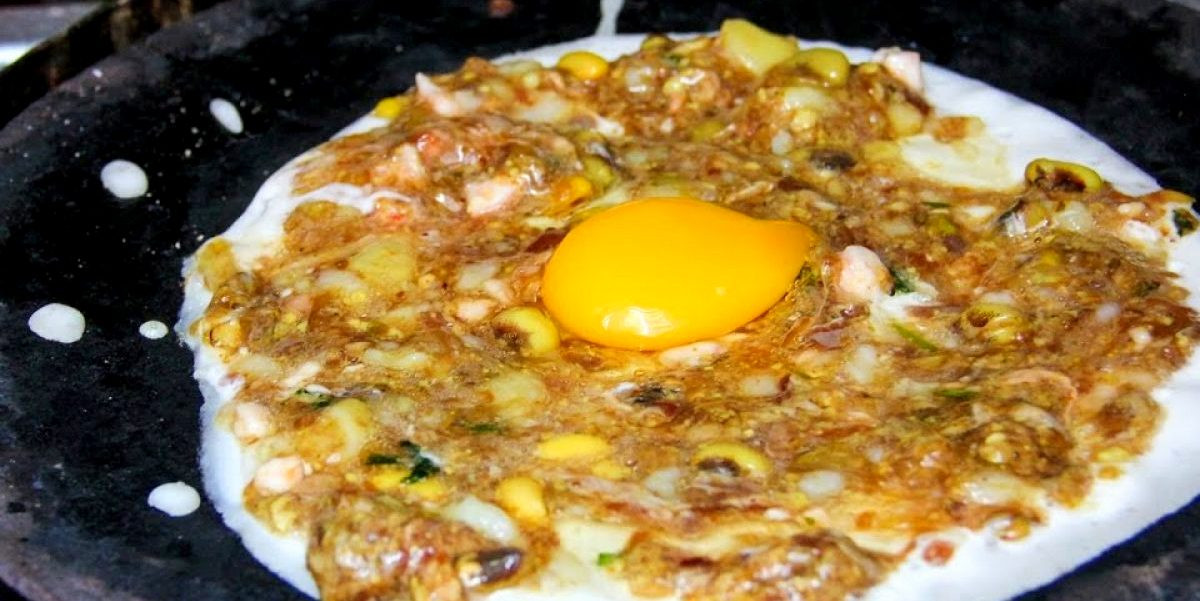
Key Features and Dishes: Newari cuisine is characterized by a wide array of dishes that range from simple snacks to elaborate meals. Key ingredients include buffalo meat, fish, lentils, and a variety of grains, complemented by unique spices and cooking techniques. Some staple dishes include:
-
Chatamari: Often referred to as 'Newari Pizza,' this dish consists of a rice crepe topped with ingredients like minced meat, eggs, and onions, seasoned with fresh herbs and spices.
-
Bara: A savory lentil pancake that can be eaten plain or topped with an egg or minced meat.
-
Yomari: A sweet treat made of rice flour dough stuffed with a mixture of molasses and sesame seeds, which is then steamed.
-
Samay Baji: An ancient traditional dish that is served on a leaf plate, featuring beaten rice, roasted meat, black soybeans, boiled egg, and a variety of pickles.
Cultural Significance: Newari food is not just about sustenance but is a crucial element of all their rituals and celebrations. Each dish has cultural significance and is prepared during specific festivals and ceremonies, reflecting the community’s relationship with their environment and deities. For instance, Yomari is typically made during the post-harvest festival of Yomari Punhi.
Eating Customs: Eating in Newar culture is often a communal activity, reflecting the community's strong emphasis on family and social cohesion. Meals are typically shared from a communal plate or leaf, enhancing the sense of unity among participants.
Health and Nutrition: Newari cuisine is also noted for its health benefits, as many of its components are fermented, such as Gundruk or Sinki, which are known to improve digestion. The use of buffalo instead of beef or pork in various dishes provides a leaner source of protein, making it both nutritious and beneficial.
Modern Adaptations: In contemporary times, Newari cuisine has adapted to cater to a broader audience, with restaurants across Kathmandu and beyond offering modified versions of traditional dishes. These adaptations make Newari cuisine accessible to tourists and non-Newar Nepalis alike, while still preserving the essence of their traditional flavors.
Experiencing Newari cuisine gives a deep insight into the soul of Kathmandu Valley’s culture, making it an unmissable aspect of any culinary exploration of Nepal. Whether it's through sampling a plate of Samay Baji during a festival or savoring a Chatamari in a local eatery, each dish offers a taste of Newar heritage and tradition.
Sel Roti
Sel Roti is a traditional Nepalese delicacy that stands out for its unique preparation and cultural significance. Often described as a cross between a donut and a bagel, Sel Roti is a sweet, crispy, and slightly chewy rice bread that is deeply embedded in the traditions and celebrations of Nepal.
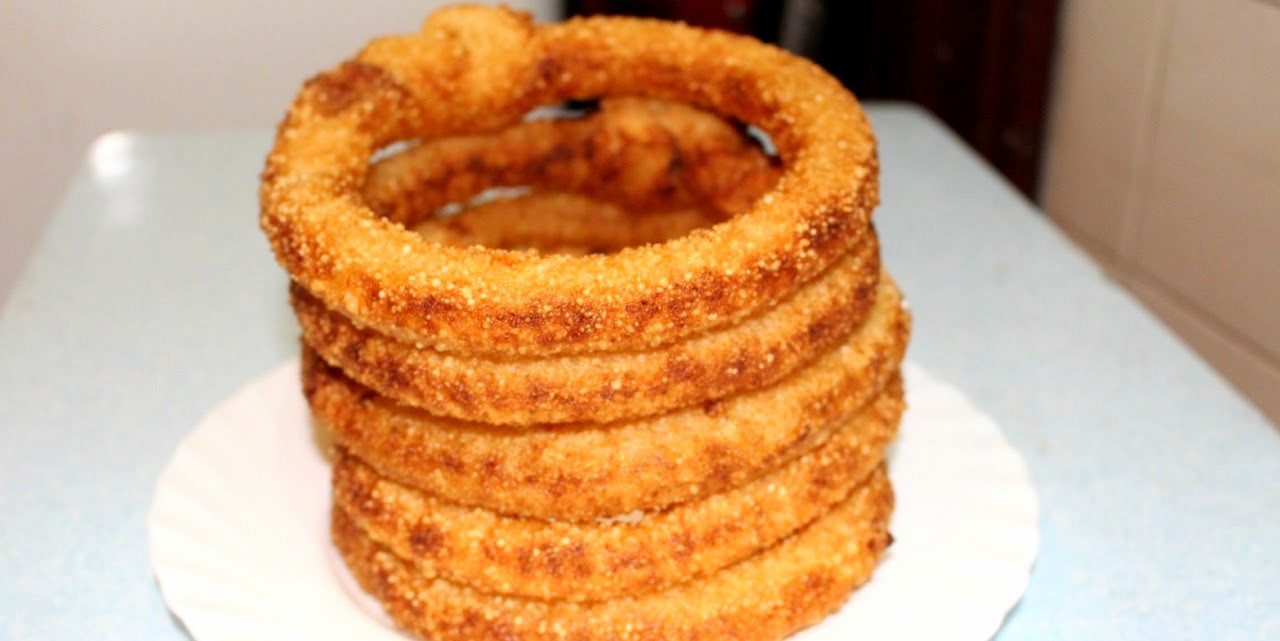
-
Ingredients and Preparation: Sel Roti is made from a batter of ground rice, which is mixed with water, sugar, and sometimes a hint of cardamom or coconut. The mixture is then left to ferment slightly before it's deep-fried in ghee or oil. The key to its distinctive texture and flavor is the consistency of the batter and the heat of the oil, which cooks the bread to a golden brown color while keeping it light and airy on the inside.
-
Occasions and Serving: Traditionally, Sel Roti is prepared during important Nepalese festivals such as Dashain and Tihar, and is often made in large quantities to be shared among family and friends. It is typically served with yogurt, vegetable curries, or as a standalone snack with tea. Its sweet and savory flavor profile makes it a versatile companion to both mild and spicy dishes.
-
Cultural Significance: Sel Roti is more than just food; it is a symbol of festivity and hospitality in Nepal. Making Sel Roti is a family activity, with techniques and recipes passed down through generations, often varying slightly between families. This culinary tradition is a way for Nepalese people to connect with their heritage and to celebrate joyous occasions together.
-
Modern Variations: While traditional Sel Roti is beloved across Nepal, modern variations have begun to appear in urban areas, introducing new flavors like chocolate and vanilla, or incorporating healthful ingredients like millet or wheat flour. Despite these innovations, the classic version remains the most popular, especially during festivals.
-
Tourist Experience: For travelers visiting Nepal, trying Sel Roti provides a delicious insight into the country’s rich culinary traditions and the everyday life of its people. It’s not uncommon to see street vendors and local eateries offering freshly made Sel Roti in the mornings, often attracting long lines of locals ready to enjoy their favorite breakfast treat.
Sel Roti is not just a food item; it’s an experience, weaving together taste, tradition, and the communal spirit of Nepal, making it a must-try for anyone wanting to delve into the flavors of this beautiful country.
Thukpa
Thukpa is a hearty noodle soup that embodies the cross-cultural influences in Nepalese cuisine, particularly the Tibetan and Himalayan flavors that have intermingled with local Nepali dishes over centuries. This warming soup is widely enjoyed in Nepal, especially in the colder mountainous regions, and is known for its comforting and restorative properties.
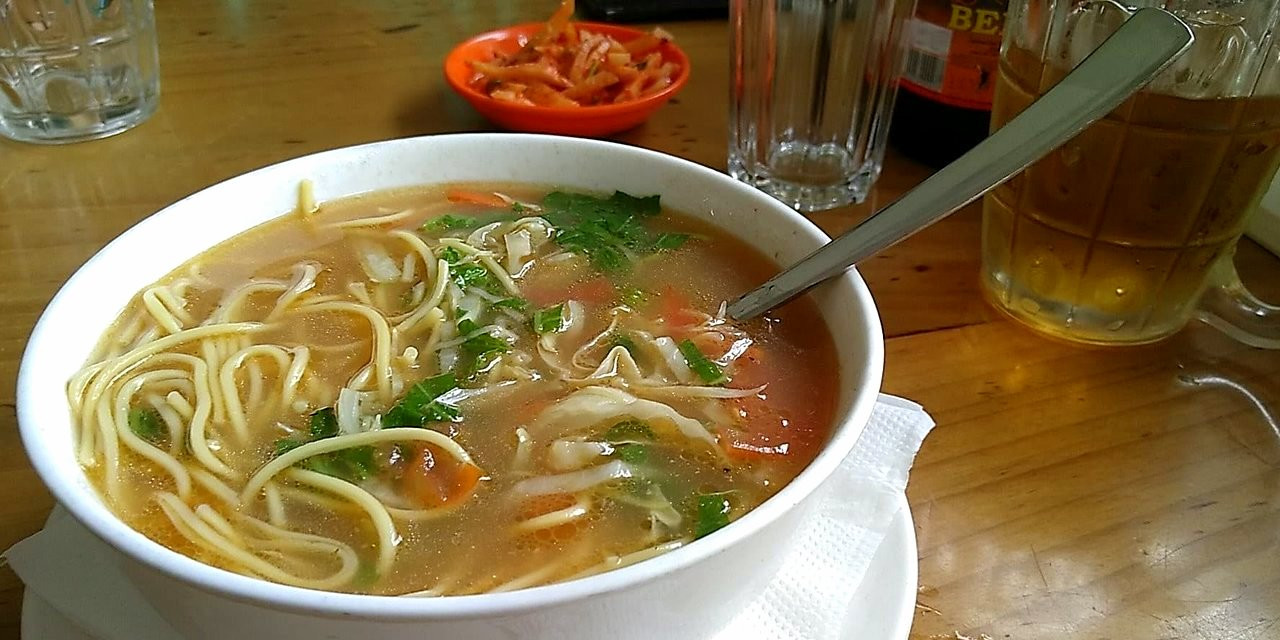
-
Ingredients and Varieties: Thukpa typically features a flavorful broth, handmade noodles, and a mix of vegetables and meat, such as chicken, beef, or mutton. The broth is enriched with spices like garlic, ginger, cumin, coriander, and sometimes Sichuan pepper, giving it a robust and warming flavor. Vegetables like carrots, spinach, and green beans add texture and nutrition, making Thukpa a balanced meal.
-
Preparation: The soup starts with sautéing onions, garlic, and spices, to which water or stock is added, followed by the meat to simmer until tender. Vegetables and noodles are then introduced to the broth, cooking until just soft. The result is a richly layered noodle soup that's both filling and nutritious.
-
Serving and Eating Customs: Thukpa is often served in large bowls with a generous portion of broth, making it a popular choice for lunch or dinner during the chilly weather. It's commonly found in local eateries, roadside stalls, and even in restaurants that specialize in Tibetan cuisine. A spoon and fork or chopsticks are typically used to enjoy Thukpa, with locals often adding a spoonful of spicy chutney to enhance the soup's heat and flavor.
-
Cultural Significance: In Nepal, Thukpa is more than just a dish; it's a symbol of cultural integration and a beloved comfort food that brings warmth and satisfaction. It's particularly popular during the winter months and is a staple in the diet of communities living at high altitudes, where the warmth of the soup offers relief from the cold.
-
Health Benefits: The combination of broth, lean meats, and vegetables makes Thukpa a healthy choice. The spices used are known for their anti-inflammatory properties, and the broth helps hydrate and warm the body, making it particularly beneficial for cold weather climates.
For travelers visiting Nepal, Thukpa offers a taste of the Himalayas that is both accessible and satisfying. It's a perfect introduction to the flavors of the region and a must-try dish for anyone seeking to experience the true essence of Nepali hospitality and culinary diversity.
Gundruk
Gundruk is a quintessential Nepalese dish celebrated for its distinct flavor and nutritional benefits. Originating from the need to preserve excess vegetables during the harvest seasons, Gundruk is a fermented leafy green vegetable dish that is deeply ingrained in the culinary traditions of Nepal, particularly among the Gurung, Magar, and Tamang communities.
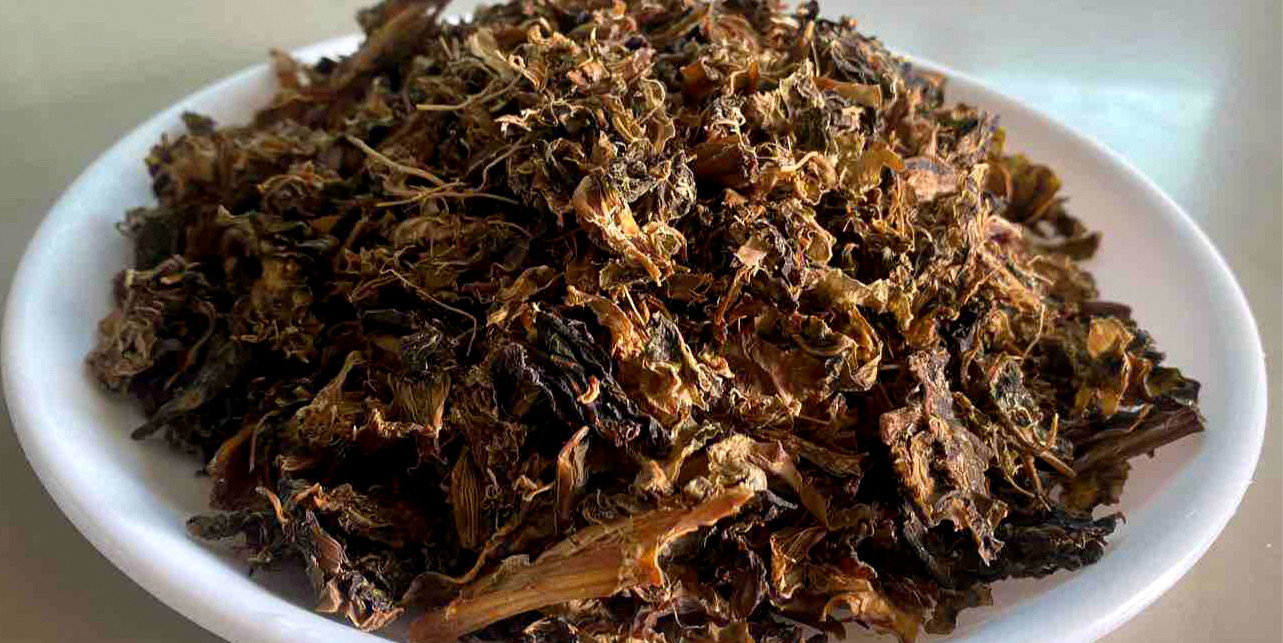
-
Ingredients and Preparation: Gundruk is typically made from mustard greens, radish leaves, and cauliflower leaves, among others. The preparation begins with wilting the leaves under the sun for a few days. Once wilted, the leaves are tightly packed in an earthen pot or a similar airtight container and submerged in water. The container is then kept in a warm place to allow the fermentation process to take place over the course of a week or more. The fermentation produces a tangy, slightly sour taste that is unique to Gundruk.
-
Serving and Uses: Gundruk can be consumed in various forms. It is most commonly prepared as a soup, known as Gundruk ko jhol, which involves simmering the fermented leaves in water with turmeric, garlic, and sometimes potatoes or soybeans. It can also be made into a pickle or served as a side dish (sadeko), mixed with fresh ingredients like onions, green chilies, and seasoned with mustard oil and spices.
-
Nutritional and Health Benefits: Gundruk is highly regarded for its nutritional value. It is rich in dietary fiber, vitamins (particularly vitamin C and vitamin A), and minerals, which are preserved—even enhanced—through the fermentation process. The fermentation also introduces beneficial probiotics into the food, which are crucial for maintaining a healthy gut flora.
-
Cultural Significance: In Nepali culture, Gundruk is more than just a food item; it represents a sustainable food practice that utilizes seasonal crops to provide sustenance during the off-harvest seasons. It is a staple in rural diets but is also popular in urban areas due to its health benefits and its distinctive taste.
-
Modern Culinary Use: In modern kitchens, Gundruk has found its way into innovative dishes that blend traditional and contemporary flavors, appearing in salads, casual snacks, and even in haute cuisine where chefs use its unique flavor profile to enhance Nepali-themed dishes.
For tourists, trying Gundruk is an opportunity to delve into an aspect of Nepali cuisine that is rooted in tradition and sustainability. It offers a taste of Nepal’s agrarian past and present, showcasing how local populations have ingeniously used natural processes to enhance their food both in taste and nutritional value. It’s a must-try for anyone wanting to experience the true depth of Nepal’s culinary heritage.
Juju Dhau
Juju Dhau is a celebrated traditional yogurt from Bhaktapur, Nepal, known widely as the "King of Yogurts" due to its rich taste and creamy texture. This delicacy is not only a staple in Newari culture but also a must-try for anyone visiting Nepal.
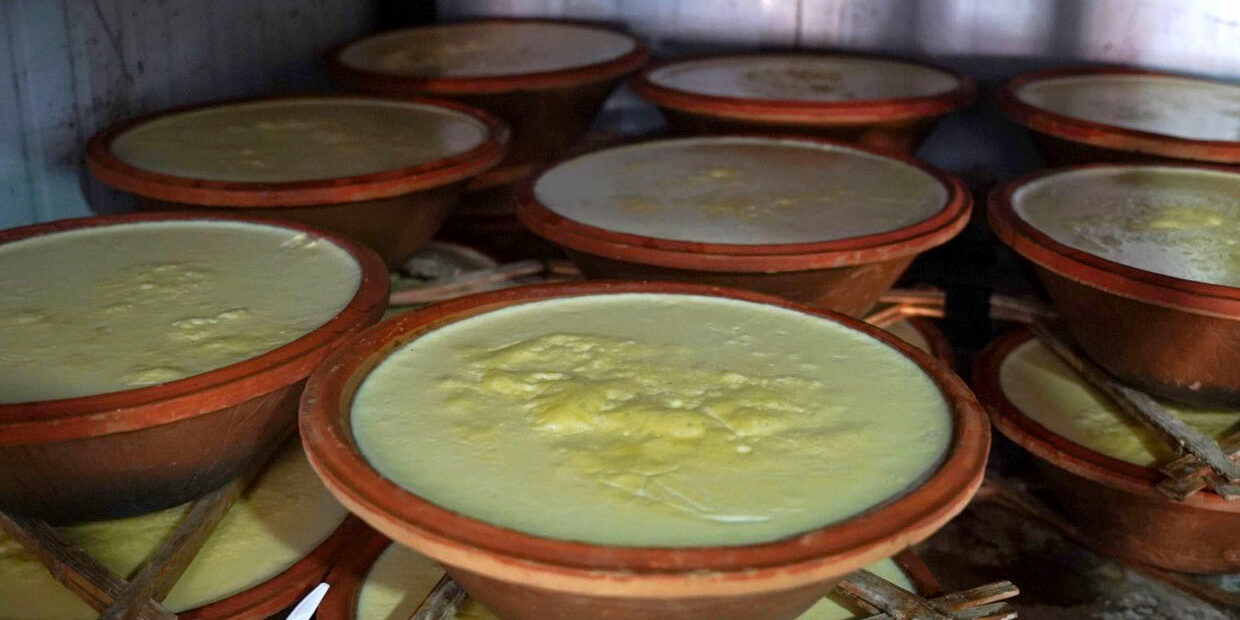
-
Ingredients and Preparation: Juju Dhau is made from buffalo milk, which is first boiled and then cooled to a lukewarm temperature. Sugar and a small amount of yogurt culture are then added to initiate the fermentation process. The mixture is poured into traditional clay pots, which are believed to absorb any excess water, thus thickening the yogurt and enhancing its flavor. These pots are then placed in a warm area, often padded with rice husks to maintain a consistent temperature, allowing the yogurt to set and develop a rich, creamy consistency.
-
Serving and Uses: Juju Dhau is typically served chilled as a dessert or as a palate cleanser after meals. Its smooth texture and sweetness make it a delightful treat on its own, but it can also be paired with various traditional Nepali desserts and fruits for added flavor.
-
Cultural Significance: Originating from Bhaktapur, one of the ancient cities in the Kathmandu Valley, Juju Dhau holds significant cultural importance in Newari festivals and celebrations. It is often used in rituals and offered to gods during religious ceremonies, symbolizing purity and the richness of the local culture.
-
Health Benefits: Aside from its delightful taste, Juju Dhau is also valued for its health benefits. Being rich in probiotics due to the fermentation process, it aids in digestion and enhances gut health. The use of buffalo milk, which is high in calcium and protein but lower in cholesterol than cow's milk, makes it a nutritious choice.
-
Tourist Experience: For travelers, tasting Juju Dhau is an integral part of the Bhaktapur experience. Often sold in the local markets and streets of Bhaktapur, visitors are encouraged to enjoy it directly from the traditional clay pots, which add a distinct earthy undertone to its flavor profile. Finding the best Juju Dhau where to buy can be a delightful pursuit in itself, as various vendors claim to have the creamiest and most authentic versions.
Juju Dhau is not just a food item; it is a reflection of Nepali craftsmanship in dairy products, a symbol of Newari pride, and an example of the culinary delights that Nepal offers. Whether enjoyed as part of a meal or as a stand-alone treat, Juju Dhau is an unforgettable part of Nepal’s culinary landscape.
Exploring the top 7 foods in Nepal is an adventure that offers more than just culinary delight; it’s a rich cultural experience steeped in history and tradition. From the steamy, spiced delicacies like Momos in Nepal and hearty bowls of Thukpa to the daily staple of Dal Bhat and the unique tastes of Newari cuisine, each dish serves as a window into the heart of Nepali life. The traditional and celebratory Sel Roti, the nutritious Gundruk, and the sublime Juju Dhau each add their own flavors to this diverse culinary palette. Engaging with these foods allows travelers not only to taste their way through Nepal but also to connect with its people and traditions in a meaningful way. Whether you are navigating the bustling streets of Kathmandu or the serene pathways of the mountainous countryside, the flavors of Nepal promise to make your journey unforgettable.
FAQs for Top 7 foods you can’t miss while traveling to Nepal
Q: What are Momos?
A: Momos are traditional Nepalese dumplings filled with either meat or vegetables. Often served steamed or fried, they come with a variety of dipping sauces.
Q: Is Dal Bhat suitable for vegetarians?
A: Yes, Dal Bhat is very adaptable and can be made completely vegetarian. It typically includes lentil soup, rice, and vegetable curries.
Q: Where can I try authentic Newari cuisine in Nepal?
A: Authentic Newari cuisine is best experienced in the Kathmandu Valley, particularly in areas like Patan and Bhaktapur, which are known for their rich Newar culture.
Q: How is Sel Roti made?
A: Sel Roti is a traditional Nepali rice doughnut, made from rice flour batter that is sweetened, deep-fried until crisp, and usually enjoyed during festivals.
Q: Can Thukpa be found in restaurants outside of Nepal?
A: Yes, Thukpa is popular in various regions of the Himalayas, including parts of India, Bhutan, and Tibet, as well as in Nepalese restaurants globally.
Q: What are the health benefits of Gundruk?
A: Gundruk is rich in probiotics, fiber, and vitamins, which aid in digestion and enhance overall gut health.
Q: How is Juju Dhau different from regular yogurt?
A: Juju Dhau, known as the "King of Yogurts," is made from buffalo milk and has a thicker, creamier texture and a richer taste compared to regular yogurt. It is traditionally fermented in clay pots which enhance its flavor.
Q: What should I know before eating street food in Nepal?
A: When trying street food such as momos or sel roti, always look for busy stalls as a high turnover generally means fresher food. Also, observe the cleanliness of the stall and how food is handled.
Q: Are there any Nepalese dishes for dessert lovers?
A: Yes, apart from Sel Roti, Nepal offers various sweets like Juju Dhau and rice puddings. Yomari, a sweet dumpling filled with jaggery and sesame seeds, is another delightful option.
Q: How can I find the best places to eat these top 7 foods in Nepal?
A: To discover the best eateries, consult local recommendations, travel blogs, and food apps. Joining a food tour can also provide a guided tasting of Nepal’s most iconic dishes.
For the Nepal tour, please click here.
If you are looking for different kinds of Nepal Tours or Trekking Packages, feel free to contact us.
